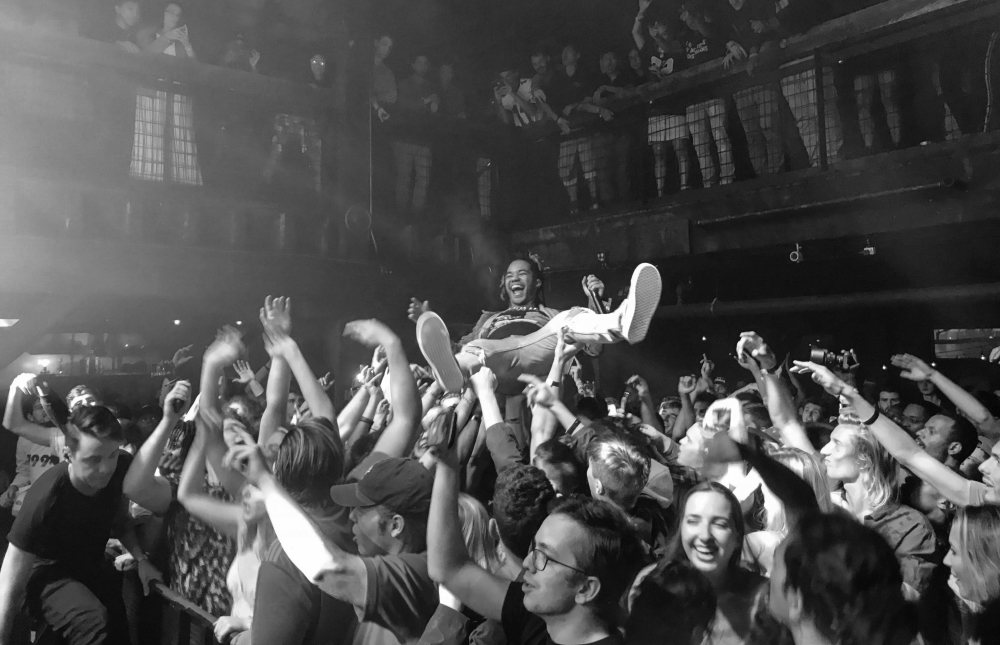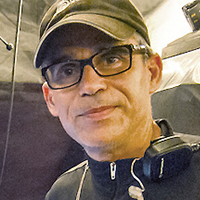Very early on in my career, I realized that it was often necessary to get from the mix position (a.k.a., FOH) to the stage, usually in a hurry. The challenge was how to do this, especially through a crowd.
Running is always a bad idea when there’s a crowd as it can cause panic. Pushing through the crowd is a good way to get, you guessed it, pushback, and the good old “’scuse me, pardon me, ‘scuse me!” routine from the Saturday morning cartoons is too hard to do at high volume levels. No, the answer turned out to be… dancing, just like everyone else was doing.
In practice, what worked was a light tap on the shoulder of the person in front of me and then dancing around them when they turned to see who’d tapped their shoulder and thought “Oh, it’s a roadie!” To that end, I always carried a prop with me, usually a flashlight, to identify me as being “with the band” or at least “working” – and not there to drink beer and dance.
For the most part, this worked quite well for all of the years that I was doing those kinds of gigs.
That said, there were a few times where it either didn’t work, or it did work, but I wished I hadn’t gotten to the stage so quickly.
Multi-Tasking
One of the latter examples happened one night in a bar in Oshawa, Ontario in 1980. The band that I was working for that year had me doing sound and lights, which kept me at the FOH position. However, I was also changing (and tuning) broken guitar strings during the show and doing my own brand of stage security, which had me making my way back and forth to the stage on a semi-regular basis as well.
On the night in question, we were part way through the second set when I saw a guy grab the singer’s tambourine off her monitor. Without giving it a second thought, I made a beeline for the stage…a beeline in this crowded, low-ceilinged club consisting of a fairly straight shot to behind the stage-left PA then around the back of the PA and over the downstage left edge of the stage and around a table until I was behind the gent with the tambourine.
Which I grabbed, with the intention of pulling it out of the guy’s hand. But he didn’t let go, and when I took some time to assess the situation, I realized that this guy was A) really big, B) really drunk, and C) really likely to do some serious damage to me, even if he didn’t really mean to. Fortunately, the singer also grabbed the tambourine as I let go of it, and when the drunk looked to see who was yanking on his prize, saw that it was the pretty lady on stage and promptly let go of it. I took advantage of that distraction to… evaporate back to the mixing console and the night ended without any further excitement.
Several years after this, I was mixing a show, a one-off, for a popular Irish folksinger at the Danforth Music Hall in Toronto. Load in, set-up and sound check had been uneventful except for the promoter deciding that the original mix position he’d allocated for us, about eight rows back, was bad for sightlines. Instead, we were in the very back row.
After sound check, my crew mate and I had gone around the corner to the New Yorker restaurant for dinner. On our return, we found a long line stretching down the block.
I’m just going to pause here for a minute to mention that from an early age I had a “thing” for Ireland, to the point where my mother used to read “The Big Book of Ireland” to me for a bedtime story. I even have relatives in Dublin, whom I’ve never met, but family legend has it that while emigrating from somewhere in Eastern Europe, they were scammed into getting off the boat in Dublin (New York! New York! Everyone to please offing the boat for New York!) and made a good life for themselves there.
So there I was, raised with very positive thoughts about all things and people Irish… until I tried making my way into the venue. I forget why, but for some reason we had to get through a considerable bit of the line to get to the front door; maybe we had ended up between the line and the storefronts instead of on the street side.
In any case, every light touch on every shoulder was immediately met with the shoulder turning to iron while the owner/operator of said shoulder slowly turned towards me and inquired things like “…and where would you be goin’ now?” or “…and what are you about then?” No one seemed to be particularly impressed with, or even interested in, my reply that we were working on the show and needed to get into the venue so that it could happen – no, we were just a couple of would-be line jumpers as far as they were concerned.
Eventually, we did make our way into the hall and through the very crowded lobby were everyone was cueing up for a pint before the show. I made it to the relative safety of the FOH position, and was there for all of three minutes when someone came up to me, waved a ticket in my face and said, “you’re in my seat!”
Well, here was a classic good news/bad news situation. The good news, that I explained to the irate ticket holder, was that they were actually going to have better seats! The bad news was that I hadn’t noted the row number of our earlier position so I didn’t know exactly where those seats were. This sent me in a frantic search for the promoter. The gentleman’s given name was “Michael” but he was known to one-and-all, including me, by his nickname, which was “Mick” – which is also a derogatory name for an Irish person.
So I then had to go through the crowded, stroppy and mostly male crowd in the lobby saying “I’m looking for Mick… has anyone seen Mick?” To this day, I’m grateful that I managed to do that, find Mick and get the seating thing sorted without getting punched out!
Handling It Like A Pro
The one time I can remember where the ”getting through a crowd quickly” thing really mattered was at a show at Toronto’s Diamond Club (now the Phoenix Concert Theatre) around 1985. I had seen in a local paper that The Band was scheduled to play there. This was a big deal for me as I had grown up listening to their records in the 1960s and 70s.
Their farewell concert, “The Last Waltz” which was also made into a movie by director Martin Scorcese, came and went in 1975, right around the time I was starting to get interested in this business so I can remember thinking, “Well, I guess I’ll never get a chance to work with those guys…”
So when I saw that they were coming to Toronto a decade later, I called a friend of mine who was the production manager for the club and asked him to put me on the crew. This he did and on the day of, I was there bright and early as we got the PA loaded in and set-up and the monitors placed on the deck. This included sidefills consisting of a three-way stack of a twin 15-inch or 18-inch sub of some sort, a Martin Audio MH-225 mid cabinet balanced on top of the sub, and a horn enclosure resting on top of the mid.
I remember very clearly that when the band’s crew (or The Band’s crew…) showed up, we were showing them what was what and when we got to the monitors, one of us said “…and the sidefills…” at which point their monitor engineer said very quickly, “I don’t use ‘em!” It was like the sidefills instantly vanished… at least as a topic of conversation.
Several hours later, during the show, I was standing at front of house (ostensibly as what we now call “system tech” except there was virtually nothing you could do except walk around and report back to the BE) when I looked up and saw the stage left sidefill stack (which no one had thought to take down) was teetering dangerously over lead singer Levon Helm, whose drum kit was set up way downstage left. (at the time, the stage was on the west side of the club and was the usual shoddy plywood construction, hence the rocking).
When I say “teetering,” I’m not exaggerating. With each beat, the sub would rock backwards and the mid and horn would tilt forward over the edge of the sub at an almost 30-degree angle. Seeing this, I took off for the stage, doing my tap/dance routine to get through the crowd, past the monitor console and up the steps to the stage. When I got to the sidefill stack, I reached around the mid cabinet, grabbed a handle in each hand and pulled as hard as I could, sliding the mid further back on the sub.
Crisis averted, I was standing just upstage of the stack, looking at Levon (who hadn’t missed a beat) and thinking to myself, “Man, I wonder if he even knew…” when he craned his neck around and gave me the big ol’ grin he was known for. So he knew all right, he was just such a pro he was going to keep on playing and singing until he had to make a jump for it!















